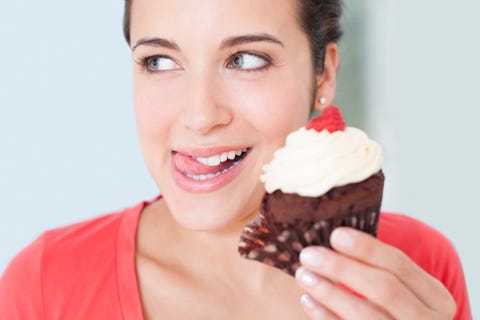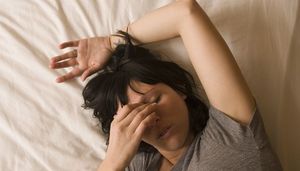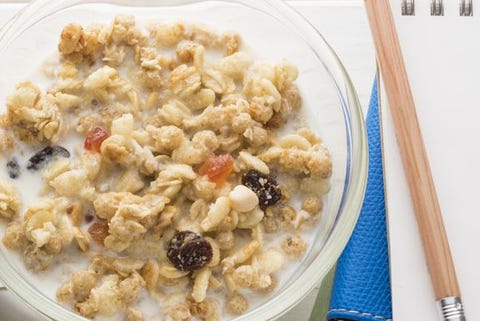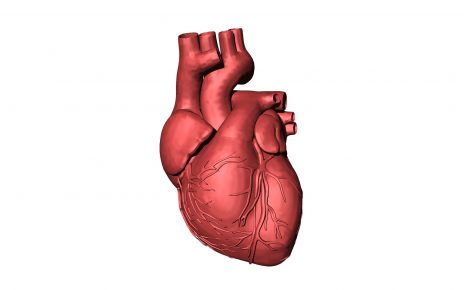
Have you ever had a delicious dinner, only to feel like you were hit over the head with a bat 20 minutes later for seemingly no reason? It totally sucks, but headaches after eating are a real thing—and there are many different culinary culprits.
Here are six reasons why you might find your head is hurting after a nosh, plus the expert-recommended way to find relief.
You might get a headache after eating because…

Getty ImagesIAN HOOTON
You had too much sugar.
Going crazy on the cookies or candy can leave you feeling sluggish, bloated, and headache-y. Why? Sugary fare causes your blood sugar to spike and quickly drop, explains Medhat Mikhael, M.D., medical director of the non-operative program at the Spine Health Center at MemorialCare Orange Coast Medical Center.
That could result in reactive hypoglycemia—or post-meal low blood sugar—which can leave you dizzy and lightheaded. To make matters worse, you might also feel weak, sweaty, or even a little shaky, according to the National Institute of Diabetes and Digestive and Kidney Diseases and the Mayo Clinic.
You’re a total salt fiend.
Eating super salty foods (think: frozen food, pasta sauces, tomato juice, and processed cheese) can leave your head absolutely throbbing. People who eat the most sodium (around 8,000 mg per day) have up to 33 percent more headaches compared to those who eat 4,000 mg of sodium per day, according to British findings. (For reference, the American Heart Association recommends consuming no more than 1,5000 mg of salt per day for optimal health.)

Why? Excess sodium increases your blood volume, causing it to take up more space in your blood vessels. “The blood vessels expand to accommodate the extra bulk, which can trigger a headache,” Mikhael explains.
You ate a migraine trigger food.
What do aged cheeses, red wine, and fancy charcuterie all have in common? Aside from being the stars of your dinner party, they also contain tyramine, an amino acid known for triggering migraines in people who are prone to them, The National Headache Foundation notes.
Foods filled with chemical preservatives like nitrates, sulfites, or MSG can also bring on migraines by increasing blood flow to the brain. These additives are often found in processed meats (like hot dogs and deli slices), alcohol, soy sauce, and canned soup, according to The National Headache Foundation resources.
You hurt your jaw.
If crunchy or chewy foods tend to leave your thinker throbbing, you might have myofascial pain disorder (MPD), or pain of the muscles that move your jaw. “Just like you can have a muscle ache after a heavy workout, the same type of pain can happen if you put your jaw muscles through a ‘workout’ by straining and clenching hard,” explains Daria Hamrah, D.M.D., of Nova Surgicare Center for Oral and Facial Rejuvenation.
That strain can lead to an achy head. To recover, ice your jaw and take an anti-inflammatory pain medication, Hamrah recommends. If the problem keeps coming back, talk to your dentist. MPD can also strike if you clench your jaw during sleep, but Hamrah says wearing a night guard can help keep the clenching at bay.
You have a food intolerance. (Well, maybe.)
Got a problem with gluten or dairy? Some findings suggest that celiac disease might be tied to migraines. There’s also evidence that links headaches (not migraines) to lactose intolerance. But the reasons why aren’t clear, and most experts aren’t entirely convinced that there’s a link. “Although there are reports by patients and healthcare professionals that attest there is an association, at this time there isn’t strong enough evidence to definitively draw a conclusion on gluten or dairy directly causing headaches,” says Laren Tan, M.D., a pulmonologist and asthmatologist at Loma Linda University Health.

But if either food seems to bother you, go with your gut and steer clear. “The symptoms of [people with food intolerances] experience can vary,” Tan acknowledges.
You have a brain freeze.
That cranium-splitting feeling when you slurp a milkshake too fast or try to polish off an ice cream cone before it melts everywhere? It’s brain freeze—or what doctors call sphenopalatine ganglioneuralgia. (Fancy name, right?) When something cold touches the roof of your mouth, your blood vessels rapidly constrict and reduce blood flow to the brain, explains Mikhael. The result is a quick flash of pain around your forehead, but don’t worry: It’ll go away within a minute or two, assures the Cleveland Clinic.
How to deal with a headache after eating

Getty ImagesUtamaru Kido
Popping a pill might temporarily ease the pain, but you’ll need to do some detective work to get to the bottom of your post-meal headaches and give them the boot for good. Whenever a headache strikes, write down your symptoms and what you ate before they flared up, Mikhael recommends. If you notice that the same food or drink seems to be causing problems, try cutting it out to see if your headaches clear up. And if they don’t go away or get worse, let your doctor know. He or she can help you pinpoint the culprit—and get some relief.
Source: Read Full Article



